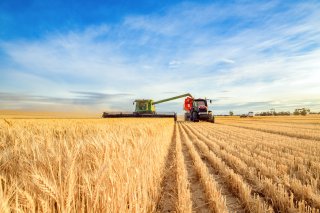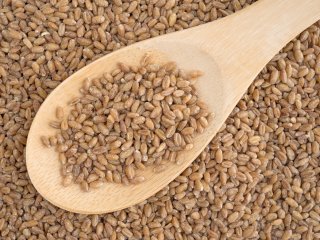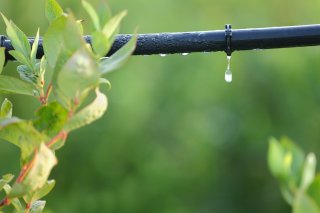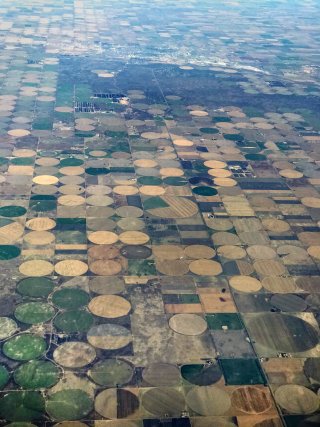Climate Change Connections: Kansas (Wheat)
Climate change is impacting all regions and sectors of the United States. The State and Regional Climate Change Connections resource highlights climate change connections to culturally, ecologically, or economically important features of each state and territory. The content on this page provides an illustrative example. As climate change will affect each state and territory in diverse ways, this resource only describes a small portion of these risks. For more comprehensive information about regional climate impacts, please visit the Fifth National Climate Assessment and Climate Change Impacts by Sector.
On this page:
Introduction: The Wheat State

Kansas is among the leading producers of wheat in the United States.1 Nicknamed the “wheat state,” Kansas grows nearly 20 percent of the country’s wheat.2 The wheat industry is a staple of the state’s agricultural sector, supporting thousands of jobs and contributing over 1 billion dollars to the economy in 2023.3 Kansas is particularly known for its high-quality hard red winter wheat, which grows well in the region’s current climate.2
Due to wheat's historical and economic importance to the state, many Kansans hold a deep sense of pride in the crop. At University of Kansas sporting events, spectators will observe crowds of students waving their hands from side to side, mimicking a field of wheat blowing in the wind in a tradition known as “waving the wheat.”
Climate Impacts: Warming Temperatures and Drought Can Decrease Wheat Yield
Kansas has been experiencing warming, particularly in winter and spring, with temperatures rising about 1.5°F since the early 1900s.4 In recent years, the state faced some of the warmest temperatures on record.4 Increasing temperatures, coupled with droughts and heat waves, present significant risks to agricultural production in the state.4

In some colder regions, rising temperatures may improve wheat cultivation by reducing frost events and cold-related damage to crops.5 However, excessive heat during the growing season (September to May) can disrupt wheat growth and lower yield, likely outweighing the benefits of reduced freezing in many places.5,6 Warmer temperatures can cause wheat plants to mature too quickly, leading to shorter and less-productive growth phases.7 Excessive heat can also decrease wheat growth as plants struggle to absorb water from the soil.7 Additional days of extreme heat in the spring can lead to decreased harvests.5 Even small losses in yield can have big economic consequences for wheat growers.
As average temperatures rise due to climate change, the Earth’s water cycle is speeding up through an increase in the rate of evaporation from the Earth’s surface and transpiration from plants. This can make more water available in the air for precipitation, but contributes to drying over some land areas, leaving less moisture in the soil. With continued climate change, some areas of Kansas that are already hot and arid may also become more susceptible to droughts. In the state, droughts are expected to be more intense in the future.4 Drought can mean shorter periods for wheat to develop, which can lead to crop failure.5 Additionally, insufficient water can lower the quality and protein content of wheat, affecting its market value and suitability for various end uses.5,8 In 2023, nearly two-thirds of Kansas’ wheat crop experienced extreme drought conditions, which likely contributed to low yields.9,10

Warmer temperatures and drought cause soil to dry out faster than it would under normal conditions.4 To combat this, farmers often increase irrigation, which can put additional pressures on already-strained sources of groundwater.11 The Kansas wheat industry relies heavily on groundwater for irrigation, and the Ogallala Aquifer, its primary source of groundwater, has experienced major depletion in recent decades. The rate at which water is withdrawn from the aquifer exceeds the recharge rate.12 With less water available due to changes in rainfall and depleted aquifers, wheat growers could be forced to reduce the area they use to grow wheat.13 Drought can also drive crop abandonment.5 This practice of leaving a sown field without harvesting tends to happen when production costs exceed expected returns.5 Farmers may abandon their crops due to soil degradation, stunted wheat growth, and lower wheat yields that make it economically unfeasible to harvest. In 2023, a year of significant drought, almost 30 percent of planted wheat acres were abandoned in Kansas—the highest rate since 1951.10
Taking Action: Agricultural Adaptations and Management Practices

Addressing climate change requires reducing greenhouse gas emissions while preparing for and protecting against current and future climate impacts. Communities, public officials, and individuals in every part of the United States can continue to explore and implement climate adaptation and mitigation measures. In Kansas, wheat farmers continue to explore adaptation strategies to maintain wheat production and enhance industry resilience in the face of warming temperatures and drought, including:
- Researching and expanding usage of drought-resistant wheat varieties. Leveraging crop varieties that are better adjusted to projected warmer temperatures and droughts is an important adaptation strategy. Researchers at the U.S. Department of Agriculture (USDA) and Kansas State University are exploring options, including using gene editing technologies to improve hard winter wheat varieties.2,14,15 Heat- and drought-tolerant wheat varieties can be more resilient and help maintain yields in a changing climate.5
- Sustainable water and soil management. Providing sufficient water can help offset some of the impacts of high temperatures.16 Sustainable systems-wide approaches, which include soil, plant, livestock, and water management, can help optimize water use while conserving resources. Agricultural practices such as drip irrigation, irrigation scheduling, and soil moisture sensors are examples of effective ways to conserve and manage water output.17 Additionally, using more conservative tillage practices can improve soil water retention, making the soil more resilient to droughts.18 While new irrigation technologies can result in long-term savings for farmers, upgrading these systems can be expensive due to installation, maintenance, and energy costs. Public financial assistance programs, such as the USDA’s Environmental Quality Incentives Program, can provide a source of funding to help farmers adopt more efficient irrigation systems.19
To learn more about climate change impacts in Kansas and the Southern Great Plains region, see Chapter 26 of the Fifth National Climate Assessment.
Resources
- EPA Climate Change Indicators: Drought
- Kansas State Climate Summary 2022 (NOAA)
- Kansas Water Science Center (U.S. Geological Survey)
- Kansas Emission Reduction and Mitigation Priority Action Plan (Kansas Department of Health and Environment) (pdf) (895.28 KB)
References
1 U.S. Department of Agriculture National Agricultural Statistics Service. (2023). Kansas wheat history. https://www.nass.usda.gov/Statistics_by_State//Kansas/Publications/Cooperative_Projects/KS-wheat-history-23.pdf
2 Kansas Department of Agriculture. (2023). 2023 Kansas Ag Summit: Wheat. https://www.agriculture.ks.gov/home/showpublisheddocument/54/638441401051100000
3 U.S. Department of Agriculture National Agricultural Statistics Service. (2024). 2023 state agriculture overview: Kansas. https://www.nass.usda.gov/Quick_Stats/Ag_Overview/stateOverview.php?state=KANSAS
4 Frankson, R., Kunkel, K. E., Stevens, L. E., Easterling, D. R., Lin, X., Shulski, M., Umphlett, N. A., & Stiles, C. J. (2022). Kansas state climate summary 2022 (NOAA Technical Report NESDIS 150-KS). NOAA National Environmental Satellite, Data, and Information Service. https://statesummaries.ncics.org/chapter/ks/
5 Obembe, O. S., Hendricks, N. P., & Tack, J. (2021). Decreased wheat production in the USA from climate change driven by yield losses rather than crop abandonment. PLOS ONE, 16(6), e0252067. https://doi.org/10.1371/journal.pone.0252067
6 Zampieri, M., Ceglar, A., Dentener, F., & Toreti, A. (2017). Wheat yield loss attributable to heat waves, drought and water excess at the global, national and subnational scales. Environmental Research Letters, 12(6), 064008. https://doi.org/10.1088/1748-9326/aa723b
7 Akter, N., & Islam, M. R. (2017). Heat stress effects and management in wheat. A review. Agronomy for Sustainable Development, 37. https://doi.org/10.1007/s13593-017-0443-9
8 Wan, C., Dang, P., Gao, L., Wang, J., Tao, J., Qin, X., Feng, B., & Gao, J. (2022). How does the environment affect wheat yield and protein content response to drought? A meta-analysis. Frontiers in Plant Science, 13, 896985. https://doi.org/10.3389/fpls.2022.896985
9 NASA Earth Observatory. (2023). A rough harvest for Kansas wheat. Retrieved October 30, 2023, from https://earthobservatory.nasa.gov/images/151487/a-rough-harvest-for-kansas-wheat
10 U.S. Department of Agriculture, National Agricultural Statistics Service. (2023). Kansas wheat history. Kansas Field Office. https://kswheat.com/sites/default/files/2023-10/wheat%20history%2023.pdf
11 Tack, J., Barkley, A., & Hendricks, N. (2017). Irrigation offsets wheat yield reductions from warming temperatures. Environmental Research Letters, 12(11), 114027. https://doi.org/10.1088/1748-9326/aa8d27
12 Rhodes, E. C., Perotto-Baldivieso, H. L., Tanner, E. P., Angerer, J. P., & Fox, W. E. (2023). The declining Ogallala Aquifer and the future role of rangeland science on the North American High Plains. Rangeland Ecology & Management, 87, 83–96. https://doi.org/10.1016/j.rama.2022.12.002
13 Cotterman, K. A., Kendall, A. D., Basso, B., & Hyndman, D. W. (2018). Groundwater depletion and climate change: Future prospects of crop production in the Central High Plains Aquifer. Climatic Change, 146, 187–200. https://link.springer.com/article/10.1007/s10584-017-1947-7
14 Kansas State University Department of Plant Pathology. (2023). Feed the Future Innovation Lab for Applied Wheat Genomics. Retrieved August 19, 2024, from https://www.k-state.edu/wheat-innovation-lab/
15 Agricultural Research Service. (n.d.). Hard winter wheat genetics research: Manhattan, KS. U.S. Department of Agriculture. Retrieved August 19, 2024, from https://www.ars.usda.gov/plains-area/mhk/cgahr/hard-winter-wheat-genetics-research/
16 Hatfield, J. L., & Dold, C. (2018). Agroclimatology and wheat production: Coping with climate change. Frontiers in Plant Science, 9, 224. https://doi.org/10.3389/fpls.2018.00224
17 Ao, Z. L., Hendricks, N. P., & Marston, L. T. (2021). Growing farms and groundwater depletion in the Kansas High Plains. Environmental Research Letters, 16(8). https://doi.org/10.1088/1748-9326/ac1816
18 Economic Research Service. (2020). Soil tillage and crop rotation. U.S. Department of Agriculture. https://www.ers.usda.gov/topics/farm-practices-management/crop-livestock-practices/soil-tillage-and-crop-rotation/
19 Schaible, G. D., & Aillery, M. P. (2012). Water conservation in irrigated agriculture: Trends and challenges in the face of emerging demands. Economic Information Bulletin, 99. https://www.ers.usda.gov/webdocs/publications/44696/30956_eib99.pdf

